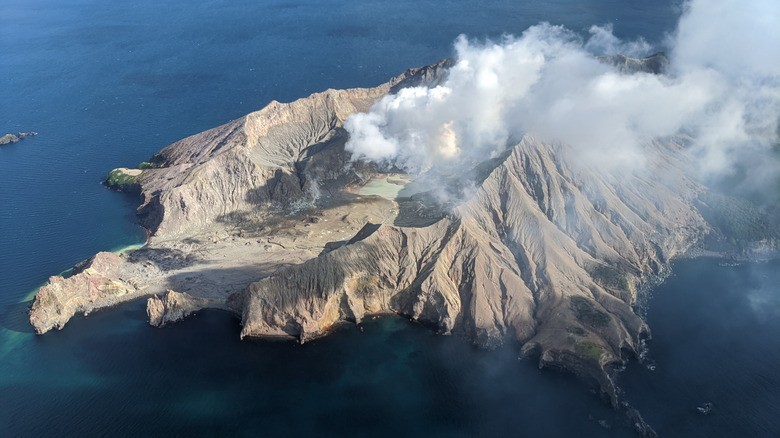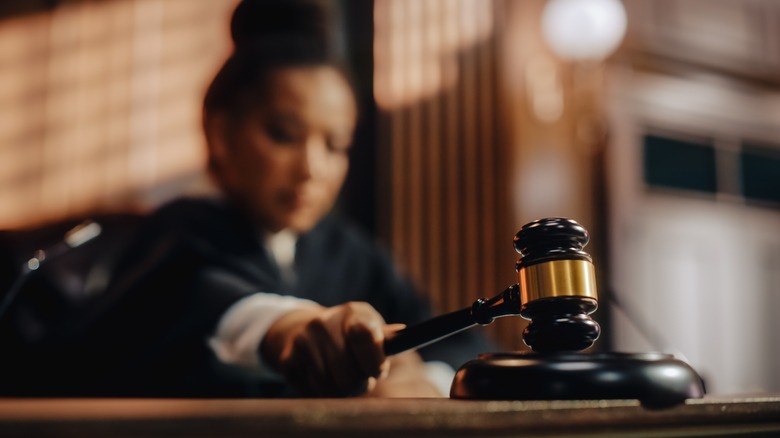Inside The Legal Battles Of Whakaari Island Survivors
On December 9, 2019, as the NZ Herald reports, dozens of tourists and support staff were visiting a volcanic island off the coast of New Zealand when it erupted, ultimately resulting in 22 deaths. Others survived, albeit with lasting injuries; one American woman who was on vacation suffered burns to 23 percent of her body and would spend months recovering in a New Zealand hospital. "My body was literally sizzling," Lauren Barham said.
The eruption of Whakaari/White Island (above) would spur multiple civil and criminal actions against multiple individuals and organizations. However, one of the entities involved in this tragedy was cruise-ship operator Royal Caribbean. The operator offered tours to the island as part of an add-on experience, allegedly despite clear evidence that the volcano was dangerous. Further, survivors and their families allege that the company's promotional materials downplayed just how dangerous an excursion to the volcanic island could be. Perhaps unsurprisingly, Royal Caribbean has tried to prevent the survivors from being able to sue them at all, as The Guardian notes.
Warning Signs
Whakaari (also known as White Island) is an active volcano about 35 miles off the coast of New Zealand, that has been erupting off and on since at least 1976, according to the Smithsonian Institution, making it New Zealand's most active volcano. Prior to the 2019 eruption that killed 22 people and injured multiple others, it had most recently erupted just three years earlier, in 2016.
Nevertheless, the island was, at the time, a popular tourist attraction (Women's Health notes that there are no longer any ways for tourists to visit the island). In particular, Royal Caribbean offered excursions to the island, for passengers on its ships sailing that part of the world, including Ovation of the Seas, which was docked there that day.
Even before the boats arrived with passengers, it was obvious that the island was unstable. Three weeks before the fateful eruption, New Zealand officials had raised the danger level of the island to Level 2. Days later, there was a 5.9 magnitude earthquake off the coast of the island.
Visitors were allowed to the island regardless, and those who visited from the Royal Caribbean ship would later claim that the cruise giant downplayed the risks. And when the survivors tried to hold them accountable, the Royal Caribbean fought them every step of the way.
Multiple Jurisdictions And Entities
The entire issue would prove to be a legal quagmire. There were multiple people and organizations facing civil and criminal exposure, including the owners of the island. As RNZ reports, 13 groups were charged with "health and safety law breaches," pleaded not guilty, and were scheduled to go to trial in 2023. One other suit was dismissed, and the defendants in another suit pled guilty.
Cruise operator Royal Caribbean might face the most legal exposure. Plaintiffs allege that they downplayed the risks of visiting an active volcano, failed to mention that it had erupted three years earlier, and failed to take into account the warning signs of the previous few days. The company has tried to ensure that they won't be sued in any court in the United States. As The Guardian reported, the company filed legal paperwork to see to it that any lawsuits against them for the incident would be adjudicated in Australia, not the U.S.; the agency lost that suit and the legal action will go ahead in Miami. In December 2022, Screen Rant reported that the lawsuits against the cruise ship operator are still pending.


